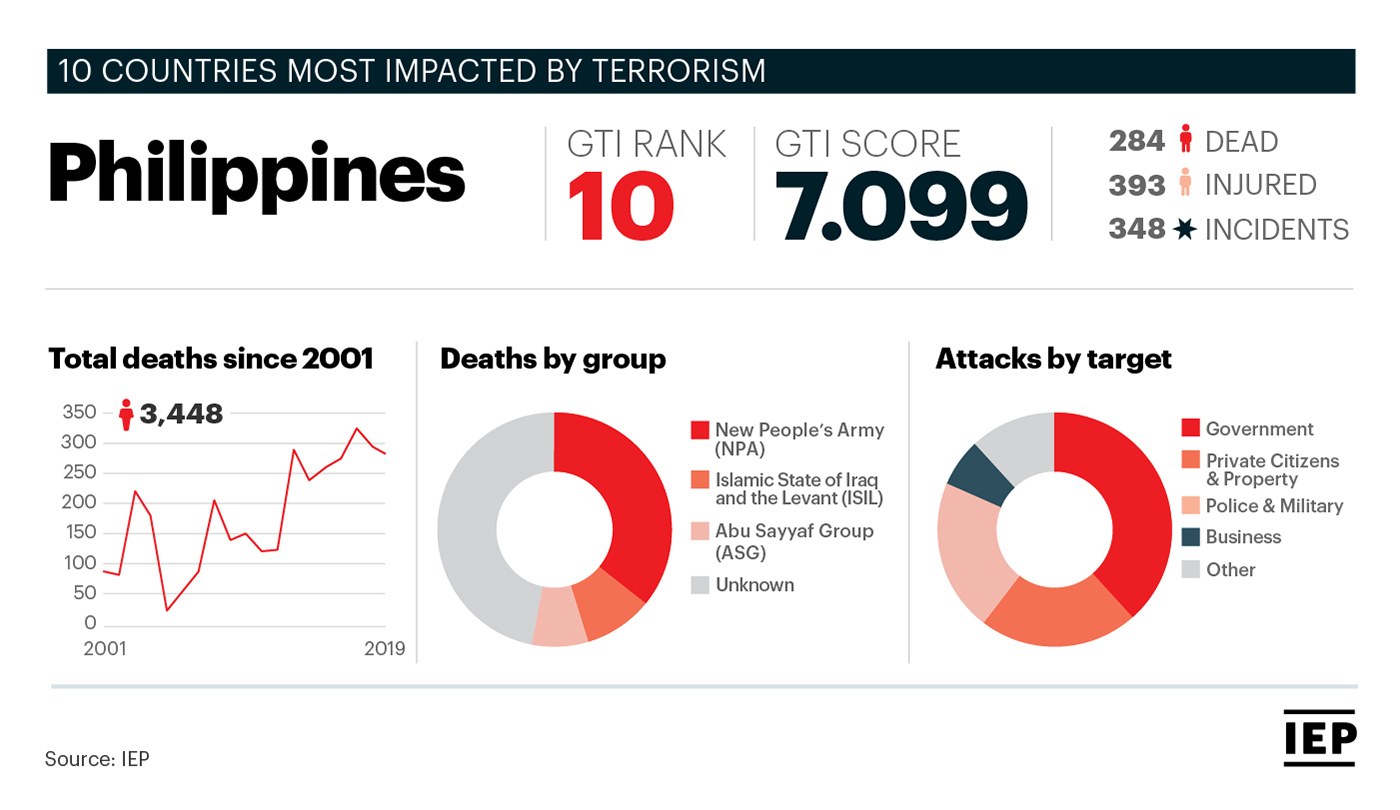According to the 2020 Global Terrorism Index, the Philippines is within the top ten countries most impacted by terrorism.
Terrorism deaths in the Philippines declined for the second consecutive year in 2019, to 284 deaths. Terror-related incidents also decreased by 18 per cent from 424 in 2018 to 348 in 2019.
Despite a slight reduction in terrorist activity, the Philippines remains the only Southeast Asian country to be ranked in the ten countries most impacted by terrorism.

The communist New People’s Army (NPA) was the most active terrorist organisation in the Philippines. The NPA was responsible for over 35 per cent of deaths and 38 per cent of terror-related incidents in 2019, at 98 and 132 respectively.
However, terrorist activity attributed to the NPA has declined since 2018 with incidents and deaths falling by 26 and 8%, respectively. The NPA has been engaged in an insurgency against the Filipino government for five decades and has been the deadliest terror group in the Philippines since 1970.
In 2019, the NPA conducted attacks across 37 provinces. The group was most active in the provinces of Negros Oriental and Negros Occidental, causing 31 deaths collectively.
However, NPA attacks on the island of Negros have fallen by 25% since 2018.
This decline follows a counter-insurgency operation, named Operation Sauron, undertaken by the Armed Forces of the Philippines (AFP) and the Philippine National Police (PNP) against the NPA.
Despite the overall reduction in terrorist violence against police, military and government targets, civilian attacks increased 17% in 2019. Approximately 53% of NPA attacks on the island of Negros were against civilians, resulting in 15 fatalities.
In the Philippines, ISIL conducts terrorist operations both on its own and through its affiliates: Bangsamoro Islamic Freedom Movement (BIFM), the Abu Sayyaf Group (ASG) and the Maute group.
These groups have all pledged allegiance to ISIL since 2014. Groups affiliated with ISIL in the Philippines continued to recruit and train fighters in 2019. The Philippines remained a destination for foreign terrorist fighters from Indonesia, Malaysia, and countries in Europe and MENA.
ISIL was the second deadliest group in the Philippines, causing 26 deaths from four attacks in 2019.
Two of the four attacks attributed to ISIL in 2019 were coordinated suicide bombings of a Cathedral in Jolo, Sulu that targeted civilians and military personnel.
Since their emergence in the Philippines in 2016, ISIL and affiliated groups in the Philippines have waged four suicide bombings resulting in 44 fatalities. Compared to other active groups in the Philippines, ISIL attacks have been significantly more lethal, causing an average of 3.4 deaths per attack.
The third deadliest group in the Philippines was ASG, recording 21 deaths in 2019. Deaths attributed to the group increased by 62 per cent from 2018 to 2019.
In the same period, the number of attacks declined by 33 per cent, indicating an increase in attack lethality. In 2019, the majority of deaths attributed to ASG were armed assaults targeting civilians and police and military personnel.
The group was also responsible for the deadliest attack recorded in the Philippines in 2019. Fifteen people were killed when assailants opened fire on civilians attending a community forum with the military in Igasan, Sulu.